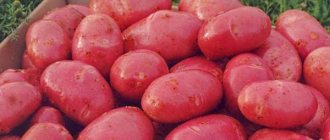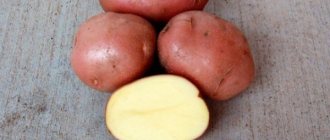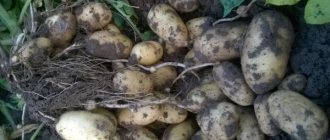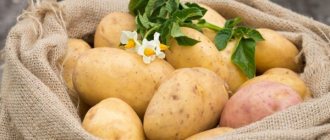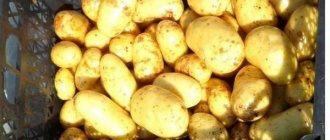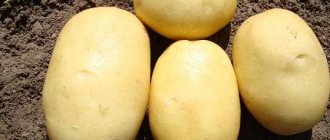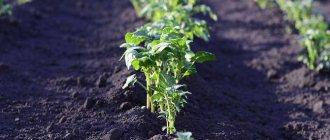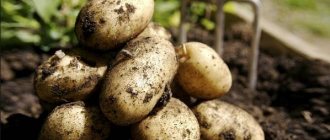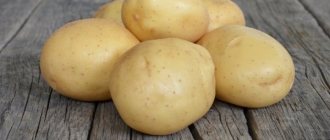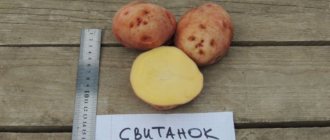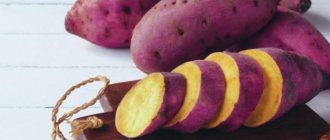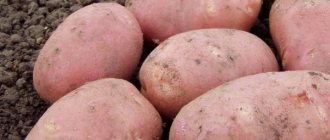Description and characteristics
The mid-early potato Krasavchik enters the technical maturity phase after 80-90 days of growth. Productivity 169-201 c/ha. The highest figure was recorded: 284 c/ha. 6-11 tubers with an average weight of 90-165 g are formed in the nest. The commercial yield of the variety reaches 85-95%. The keeping quality of tubers is 97%.
Semi-erect, medium-sized bush of the potato variety Krasavchik (Krasavchik) with regular foliage. The corollas are white with a slight anthocyanin tint. The plant tolerates short dry periods well. Oval tubers of the Krasavchik variety are covered with a smooth, reddish skin. The eyes are small. The creamy flesh is dense. Thanks to the firm structure of the pulp, the Krasavchik potato can withstand mechanical damage and is suitable for transportation.
The starch content is high - 12.4-17.8%, but the tubers remain intact during cooking. The taste is pleasant, after heat treatment the pulp is light. The variety is good for frying, French fries, and salads. Processing plants purchase the Krasavchik variety for the production of chips and dry puree.
Handsome is immune to potato cancer and viral mosaics: striped and wrinkled. The variety is moderately sensitive to infection of tubers and stems by late blight, but is susceptible to infection by golden cyst nematode.
Harvest and storage
Harvesting begins in August. Tubers that have reached technical maturity are practically not subject to damage. They are dug out of the ground with a pitchfork or shovel and left on the site to dry. In cloudy weather, the crop is harvested under a canopy so that the tubers are not wetted by rain.
Drying takes 2-3 days, after which the crop is ready for long-term storage.
Keeping quality of the variety, storage conditions
The variety has an increased shelf life; regardless of the length of time, the presentation is preserved in 97%. The room in which the harvested crop is left must be dry, well ventilated and dark.
Vegetables are stored in wooden boxes. They are transported in the same boxes.
Advantages and disadvantages
| Advantages | Flaws |
| Good taste, classified as high starchy (from 14 to 25%) | Not everyone likes tubers that don't boil |
| High consumer qualities: beautiful tubers, transportability, keeping quality | Susceptibility to golden nematode |
| Excellent sales outlet | |
| Long period of rest | |
| Resistance to mosaic viruses and potato blight |
Taste qualities of potatoes
The pulp of the Krasavchik potato variety is dense and juicy, and the taste of the tubers is highly rated. The variety is classified as a high-starchy variety - the starch content in the fruit reaches 17-18%.
Heat treatment does not cause darkening of the tubers. In addition, after cooking the potatoes do not become soggy. The variety is used to prepare dry mashed potatoes and French fries. The tubers are also suitable for frying when peeled, cooking potatoes in their jackets (the skin of the Krasavchik variety does not crack when exposed to high temperatures) and baking. Due to the fact that the Krasavchik variety retains its shape well, the tubers are added to soups and salads.
Landing
The Krasavchik variety is suitable for any soil. You just need to determine the acidity of the soil. The Krasavchik potato develops best in soils with an acidity level of 5.0–5.5. Potatoes are planted in fields where forage grasses, grains, and legumes were grown. Avoid areas where sunflowers grew last season, tomatoes and sorghum were grown. For full ripening, potatoes need good lighting of the bushes, so the rows with the Krasavchik variety are placed in a southerly direction.
- Acidic soils are limed in the fall: applied per 1 square meter. m 500-700 g of lime or 200-300 g of dolomite flour.
- An autumn application of humus of 5-10 kg and 60-70 g of superphosphate is effective. Fresh manure is applied a year earlier, under previous crops.
- Krasavchik potato tubers are planted according to the pattern 60-70 x 25-30 cm.
- 50-80 g of wood ash are placed in the holes.
Tubers of the Krasavchik variety selected for planting must be healthy, without flaws, and elastic. Potatoes are vernalized for 30-40 days at a temperature of 12-15°C, laid out in boxes in 2-3 layers. Light sprouts of the variety "Krasavchik" are pink. Before planting, the sprouts must grow to 1 cm. Potatoes are planted when the ground warms up to +8°C to a depth of 10 cm. Directly in the boxes they are sprayed with growth stimulants and before planting insecticides to combat Colorado potato beetles.
Comment! White sprouts formed in the basement during storage are removed.
Tips and reviews from gardeners
Tips from vegetable growers regarding harvesting:
- Carry out cleaning in clear and dry weather. During rains, the likelihood of tubers being damaged by wireworms increases.
- Three weeks before harvest, dig in the potato foliage. The stems will dry out, and all the starch will go into the tubers.
The culture receives positive reviews quite deservedly. Gardeners willingly share them.
Olga, Kostroma: “ I planted 20 kg of Krasavchik potatoes last year, the harvest was good. I collected 2.5-3 kg from the bushes, the tubers themselves weighed on average 100 g. I didn’t particularly fertilize the seedlings. The potatoes have a pleasant taste, I liked it. A special plus for me personally is that the tubers do not boil over. I will definitely plant more.”
Anton, Tambov: “I recognized Potato Krasavchik from the description of the variety and a photo from the Internet. I've been growing it for 2 years. Everything is fine, I am reaping large harvests. The tubers are smooth, beautiful, and always sell well. Care: I regularly carry out preventive treatments and feed with Nitrophoska. I'll definitely keep it for the winter. Vegetables are perfectly preserved until spring, without losing their taste or appearance.”
Care
Krasavchik potato seedlings are regularly cleared of weeds and the soil is carefully loosened. Watering is carried out when there is abnormally dry spring weather. Potatoes especially need to moisten the soil to the depth of old tubers, when buds form and after flowering. It is not recommended to water the plantings until the stems reach 10-12 cm. 3-6 liters of water are consumed per bush, in hot weather the volume increases to 12-20 liters. Irrigation affects not so much the number of ovaries as the size of the tuber.
Attention! Significantly, the yield of the Krasavchik potato variety will increase watering to a depth of 20-30 cm.
Hilling and feeding
Hilling the bushes two or three times will have a positive effect on the harvest. Spud up with dried but still damp soil after watering or rain. The first time the height of the ridge is up to 12 cm, the next time – up to 20 cm. It is recommended to hill the bushes on both sides, without pouring soil into the center of the bush.
They begin to fertilize the Krasavchik potato variety when the plants reach a height of 15 cm: with urea, mullein or chicken droppings. Before flowering, feed with wood ash or potassium sulfate, and after - with superphosphate.
Advice! First, dissolve the entire required volume of superphosphate in 1-3 liters of hot water throughout the day, and then dilute it for feeding.
How to properly care for potatoes
Proper and timely care will make it possible to obtain a large and high-quality harvest. Be sure to carry out fertilizing, loosening, removing weeds and watering. If there is a need, then irrigation procedures are carried out, which will have a great effect on growing potatoes in any soil.
The procedures that are necessary for proper care of potatoes are no different from the standard procedures of any other type. The soil for potatoes must be fertilized and fertilized.
- Many gardeners advise feeding the plant once with mullein or bird droppings. The droppings are diluted in water at the rate of 1-2 liters of mixture per 1 bush.
- High-quality manure is added just before planting, under the plant. Such an event will help increase productivity several times. Fertilizing can also be done after planting.
- When flowering comes to an end, foliar feeding is applied. It shows good results, as it comes along with phosphate fertilizers.
- Fertilizers containing nitrogen can be applied, but together with potassium. Do not use large amounts of wood ash.
Growing corn, corn varieties
Diseases and pests
| Diseases/pests | Signs | Treatment |
| Late blight | Brown spots on the plant, later a grayish coating appears. At temperatures close to +10°C and cloudy weather, within two weeks the fungus spreads throughout the entire area and destroys the crop. | Preventive measures include treating Krasavchik potato bushes with fungicides Tattu, Ridomil Gold, Acrobat MC and others. Folk remedies are used: 200 g of milk or one tablespoon of hydrogen peroxide is mixed with 30 drops of iodine and dissolved in 10 liters of water. The bushes are treated with the compounds three times every other day. |
| Black scab, or rhizoctoniasis | Small dark spots on the stems of young shoots develop into white rot Plants die | The diseased bush is removed and burned. Treat the area with fungicides |
| Potato L virus | The tops are light green, the leaves are curled, then turn pale and break | All tubers are unsuitable for planting and storage. The pathogen is transmitted by aphids. Spray potatoes against aphids with insecticides or soap solution: 100 g per 10 liters of water |
| Golden nematode | Microscopic worms live on the roots. The bush turns yellow, the leaves fall off. The roots are fibrous. | It is necessary to burn the dug up bushes and observe crop rotation |
Description of the potato variety Krasavchik
The Krasavchik potato belongs to the productive varieties of medium-early ripening. Potato bushes are erect and low. The leaf blade is green, slightly corrugated along the edges. The variety blooms with whitish-pink flowers with a yellowish anther.
According to the description, the potato tubers of the Krasavchik variety are oval-shaped, even, as can be seen in the photo, and smooth to the touch. The peel color is light pink. The eyes are small, but there are quite a lot of them. The pulp of the tubers is creamy.
The average weight of the fruit is 150-160 g. Potatoes ripen in 85-90 days from the moment the first shoots appear.
Important! A distinctive feature of the Krasavchik variety is its resistance to mechanical damage, which makes it suitable for cultivation on an industrial scale.
Reviews about the variety
First and second courses are prepared from this variety; it can be processed into French fries, and also used as a raw material for dry mashed potatoes. Vegetable growers speak positively about the quality characteristics and yield indicators of the “Krasavchik” variety.
The most delicious and productive potato varieties:
A big plus when choosing seed for a personal plot is the variety’s unpretentiousness in care. Many people do not have the necessary amount of time for timely care of potato plantings, but the correctly selected tasty and undemanding variety “Krasavchik” allows you to get an excellent harvest.
Peculiarities
To achieve maximum productivity from this variety, consider its following features:
- the plant loves an abundance of sunlight, so in a shaded area it will direct its main efforts to growing tops;
- keep a distance of 30 cm between bushes and 60 m between rows;
- bury the seed tubers into the ground 8-10 cm.
Attention! It is contraindicated to plant these potatoes in one place for two years in a row. The originators recommend re-planting the crop in the same area only after 3 seasons.
Characteristics:
- It is a mid-early variety. The growing season is 80-90 days;
- Productivity reaches 169-201 kg per hundred square meters, and the maximum is 284 kg;
- It is resistant to drought and relatively resistant to mechanical damage.
Growing potatoes of the Krasavchik variety is no more difficult or easier than potatoes of most similar varieties. It is only important to timely prevent the appearance of potato nematodes. These are microscopic worms that settle on tubers and roots and suck the juices out of them. Premature yellowing and drying of the lower leaves is one of the signs of a plant being infected with a nematode.
Crop rotation is important to prevent infection. It is very undesirable to grow potatoes in general, and the Krasavchik variety in particular, for several years in a row in one place. You should not plant potatoes after any nightshade crops (tomatoes, eggplants, etc.). Potatoes selected for planting should be washed well with warm water in the fall before storing and stored separately from the rest of the crop. Seed potatoes should be renewed every few years by purchasing them from a safe place.
One of the signs of the appearance of a nematode is the formation of so-called cysts on the roots
Tansy, mustard, and asters planted near potato beds help in the fight against nematodes. When digging the soil for potatoes, the remains of marigold, sweet clover or calendula plants are plowed into it. The earth must be dug up in the fall, and as deeply as possible. Chemicals (Nematicid, BI-58) should be used only if a nematode is clearly present.
Most often, with proper agricultural technology, potatoes cope with uninvited guests on their own. Planting and growing of this variety are standard. Handsome grows on any soil, but loves slightly acidic soils (pH about 5.5). The soil is fertilized with humus or compost, and the tubers are germinated a little in sunlight before planting.
As long as the bushes allow, the rows are loosened and weeded, then the potatoes cope with the weeds themselves. Before flowering begins, it is hilled twice. The fight against the Colorado potato beetle is the same as for any other variety. Watering is only necessary in case of prolonged drought, but during bud formation and immediately after flowering, the soil must be moderately moist. It should be moistened to a depth of 30 cm.
The beetle is best collected by hand
Krasavchik potatoes are fertilized mainly with mullein and ash. Mullein is used long before flowering, an infusion of ash is used immediately before flowers bloom and after flowering ends. You can dig up bushes for selective harvesting already in mid-summer, but complete digging is carried out no earlier than mid-August. For long-term storage, potatoes are dug up as late as possible.
I have a different variety of potato, but it has the same property as Handsome: in the bushes during digging, in addition to already grown and mature tubers, there are small ones on thick stolons. That is, the bush is at the same time, as it were, already ready for harvesting, and could still grow only the small potatoes that have started. This year we have a warm and dry autumn, so after digging up a couple of bushes and seeing such a picture, I postponed harvesting for a week so that the small things could grow.
I also have a different approach to such varieties. Perhaps this is a long-known know-how, but I came up with it myself when one summer I wanted new potatoes, and it was a pity to spoil the whole bush. I run my fingers under the roots (fortunately the soil on my site is loose), feel for large potatoes there and take them out.
Technology for harvesting two crops from one bush:
- Dig up the bush, stepping back well from it so as to minimally touch the roots.
- Roll the bush to one side and select large potatoes.
- Return the bush to its place again, cover the roots, water and mulch with at least dry soil.
- weed the soil to remove weeds, hill up with damp soil when the tops reach 12-15 cm. Hilling up is carried out from all sides, raking the soil to the center of the bush;
- water the plantings during periods of drought. One bush should require at least 3-4 liters of water. Watering is especially important during flowering and ovary formation;
- Fertilize the soil as soon as the potato tops reach a height of 10-15 cm. You can use urea, mullein, wood ash, potassium sulfate and other substances. The total number of feedings should not exceed 3 times;
- treated against pests and diseases. Since the variety is vulnerable to late blight, potato bushes are treated with chemicals such as Ridomil, Acrobat, Tattu and others. You can use traditional methods; they are as effective as store-bought products. Insecticides will help against insects.
Handsome reaches the technical maturity phase in the second half of summer. You can try the first tubers from mid-July or even earlier, but you should not completely dig up the entire crop at this time. The skin on the fruit is still very thin, which means that such a vegetable cannot be stored for a long time and will quickly deteriorate. It is better to completely dig up the crop closer to the beginning of August. When the tubers ripen, the tops will turn yellow and bend to the ground. At this time, you need to cut it off, and then after a couple of weeks start digging.
Potatoes are harvested in sunny weather, since the fruits must dry well before the final harvest for storage. The dug up dried vegetables are sorted by size, discarded from diseased and damaged fruits, then placed in wooden boxes with slots or packed in bags and stored in a basement, cellar, closet, veranda, etc.
READ MORE: Sprouted beans: benefits and harms for the human body
It is important to know whether it is possible to cut off the tops of potatoes after flowering.
